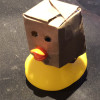Object proportions are off in the slicer compared to Blender
I modeled an object in Blender intending to print it, but when I import it into PrusaSlicer or Cura, the dimensions don’t quite match.
In Blender, the dimensions are 178mm x 142mm, but when I import it into Cura or PrusaSlicer, it imports it as 180 x 138mm. I can manually adjust the dimensions, but why is this happening? And will it mess up my fit in the end? Who do I trust here? I don’t want to waste hours printing for nothing.

Add comment